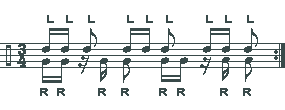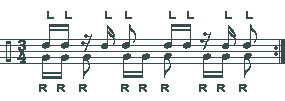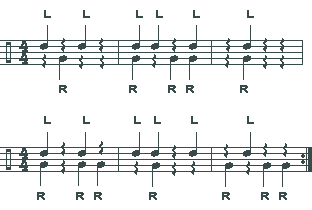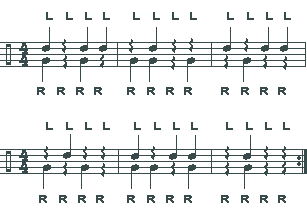
Our previous lesson
on Polyrhythms got into quite a bit of technical detail. Our purpose in
doing this was to give you a firm understanding of what's happening in
a Polyrhythm. As in many of the lessons here, what I'm trying to do is
to get you to think for yourself and develop your own exercises, rather
than just giving you some cool licks to cop. (The other goal is to help
you develop your technique so you can be more versatile.)
This lesson is going
to be quicker than the previous Poyrhythm lesson; I'm going to give you
further examples of how Ployrhythms work, and I'm going to suggest how
to further develop your own Polyrhythms using basic Rudiments.


We can take Polyrhythms
to extremes if we want to; sometimes these rhythms we develop may not work
in our current band context, but they can help us further hone our skills
as a drummer and sharpen our thinking. Who knows, maybe some day you can
throw one of these in as a rhythm on some original song, or as a fill.
The notation on the
following exercises seems to imply that they are to be played on the snare
and floor tom; play them just on the snare - they are written out this
way for clarity.



This rather slippery
little rhythm is a cleveryly disguised melding of 3/4 and 4/4. The top
line is 3/4, and the bottom is 4/4. It is notated in 3/4, but it can also
be notated in 4/4 - can you figure out how to do this? Start slow, get
fast, slow down.
When you have mastered
this, switch hands (3/4 with the right hand, 4/4 the left):

Do this while watching
your hands, and while not watching your hands. Which is easier? Why?

Here's one that will
drive you crazy. The right hand is playing the "4/4" line, as
in the first staff above. But, rather than just playing quarter notes with
the right hand, we're playing three notes. Please note that eighth notes
and sixteenth notes, especially in the top line. I could have thrown in
a sixteenth rest there, but I wanted to see if you could catch the eighth
note.
I find this alot
easier to play if I don't watch my hands! Here's the alternate sticking:

This may sound pretty
typical just on the snare, so try it on a tom and snare. Woa! You'll find
it harder to do at first. This would make an excellent exercise around
the kit.

Here's our old friend
the Paradiddle. Remember the Paradiddle?

And here's another
old friend, the Double Paradiddle:


Now, here's why I
wrote these both out: what I'm going to do here is put the Paradiddle in
the right hand, and the Double Paradiddle in the left hand:

Now, don't let all
that confuse you - just read the music as written and play it through.
You'll see that everything resolves itself after six measures and it all
starts over again.
Here's the alternate
sticking (the Paradiddle is in the left hand, the Double in the right):



Does this have any
application to the real world? Yes and no. You probably won't be using
any of these playing "Proud Mary" or "Drive" at your
next gig. However, you will find that your independence dramatically
improved over time, and that will just make you a better drummer!
Grab yourself some
staff paper and start combining other common Rudiments. There's no limits,
really. If you find this too easy, then add your kick foot doing a third
Rudiment!
As always, let me
know how you've done!





|